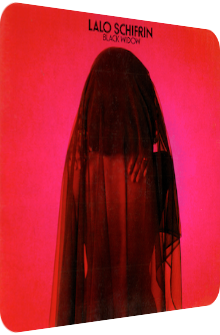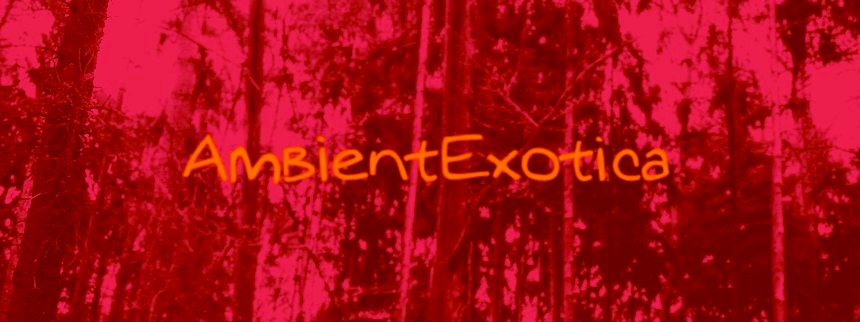
Lalo Schifrin
Black Widow
1976
It is the year 1976, conductor and arranger Lalo Schifrin (born 1932) records his eight-track LP Black Widow in March and sees it released in the same year on CTI Records. Business as usual. Or is it? In hindsight the album answers a question no-one really dared to ask: what happens if Exotica goes Disco? No, seriously: what if the famous tropical themes are ennobled or, depending on your personal mileage, perversely permeated by keyboards, sleazy backing vocals, glittering horns and ever-hedonistic drums? It turns out that the result is less of a malevolent mess than a hyper-colorful trip to the sugar-sweet no man's land located in-between Afro-Bop and Funk. And best of all: this album features three Exotica standards which are adamantly turned into glamorous glitter glimpses. Another three tracks are written by Lalo Schifrin himself, with the remaining two tunes being themes of famous Hollywood movies that face the transformation to Disco dazzlers as well.
Lalo Schifrin merges shedloads of keyboards and synthesizers and unites them with an orchestra comprising of 32 musicians. Fresh horn eruptions, clean string washes, floating flutes and multiple wah-wah guitars reign in this setup. The most intriguing part and the sole reason this album appears on AmbientExotica is, of course, the Exotica material. If this was not included, I would have skipped Black Widow entirely. Even though Lalo Schifrin is known for concocting splendid Far Eastern material, for instance with vibraphonist Cal Tjader on their collaborative effort Several Shades Of Jade (1963), Black Widow is anything like that. Its Exotica-related twists are good enough for me to consider an in-depth review of it anyway. Does the vintage Exotica material suffer from the ferocious debauchery called Disco? Or does the sybaritism boost the already joyful carefreeness? And what about the remaining material, among it the best known two-note composition of all times, John Williams' theme from Jaws? Black Widow has a lot of layers, so let's enter the Disco Inferno… overclouded with Exotica smoke machines.
The Disco infusion is kicked off with Lalo Schifrin's own Black Widow, a tune that is reminiscent to the Theme From Shaft. The rose-tinted string waves spiral effervescently, the beat is strolling in a cool way and the brass stabs are sanguine. Below these ingredients wafts a wah-wah guitar, but it is only when the synthesizers come into play that the tune changes its physiognomy from the potential widow dressed in black to the malevolent spider of the same name, for the Space-Age tone sequences are driven upwards, their cacophonously plinking shard-like nature cuts through flesh and skin, evoking a quirky kind of danger that is then safely carried away by the euphonious horn-and-string thicket with an admixed cowbell cobweb. The song is deliberately over the top and not exotic at all. This does change, and decidedly so, with the next two tracks, which are essential gold standards in the Exotica worlds, but discoed up to galactic regions.
Ted Grouya's tropical love anthem Flamingo launches as a great hybrid of a Lounge-Funk rhythm guitar which sees its golden shimmer further illuminated by electric piano droplets and seraphic-aqueous synth melodies. The genuine dreaminess of this classic decreases in favor of a wondrously easygoing afternoon atmosphere with wonky-elastic blebs, Brazilian percussion and trumpets which carefully build the climax for the chorus. The melody of Flamingo is always crystal clear and cleverly embedded in-between the improvised segues which are more about the textures and the interplay of the orchestra rather than particularly catchy melodies. Some people may see this saccharine glitterball glob as an affront, but Ted Grouya's melody is indeed indestructible.
Up next is Les Baxter's Quiet Village, the most-considered Exotica hymn of all times. For almost six minutes, Lalo Schifrin drops a concrete jungle downbeat with a slick city feeling, thus camouflaging the original's impetus, at least at the beginning. The main melody is then unchained by the means of superbly texturized polyphonous synth crystals of the Oberheim kind with a weird duality of incandescence and dissonance. Cyberbirds chirp in the background, Funk guitars fill the alcove-laden atmosphere, doo-doo chants put the finishing touches to the astonishingly transparent arrangement. Only a few electric guitars are added in adjacency to the Fender Rhodes sparks, the remaining ingredients are few and far between. Believe it or not, but I like this version. It cannot beat one single vintage Exotica version out there, but due to its minimalism, the decay, sustain and reverberation of the synths works all the better, causing vivacious echoes in an already neon-lit jungle of a big city. A real delight in the given context!
The last tune off side A is the medley Moonglow/Theme From Picnic. The former is written by Eddie Delange, Irving Mills and Will Hudson and is a lackluster Casio keyboard-driven piece of sunshine (!) with the typical wah-wah guitar coils, lachrymose strings and a cheesy impression by John Faddis on the trumpet, whereas George Duning's Theme From Picnic is taken from the eponymous '55 movie starring William Holden and is seamlessly interwoven with the soundscape. Both songs later rise to fame in the later half of the medley due to their positively glistening strata and melodious climaxes. In the end, the medley can be deemed somewhat valuable due to its hypnotic midtempo, the traversing instruments and their reoccurring entries.
Side B features another true-spirited Exotica cut, but actually launches with John Williams' theme from Jaws, a curious but intriguing inclusion. For over six minutes, the infamous two-note motif is presented on a hammering abyssal piano while churning wah-wah synth percussion whirls along the positively pumping atmosphere. Short inclusions of caixhas, bongo cascades and sun-soaked electric piano chords lighten up the action-filled smokescreen which otherwise boosts the pressure with ashen strings and dusky trumpets. Need a more tropical-gleeful apparition? Ary Barroso's Baía (or Bahia in its North-Americanized form) comes along, naturally spiced with Disco essences à la spacey keyboards, dark matter guitar twangs and brass vesicles, but also quite exotic due to its prominent bongo driblets and cowbell clangs which can freely unfold in the downbeat structures. The tempo is similar to Schifrin's take on Quiet Village, and while the melody is astutely carved out, the texture of the glacial synth strings does not enchant as much in tandem with their real brethren as the multi-faceted keyboard phantasmagoria on Les Baxter's hit.
The final two tunes are Lalo Schifrin originals: Turning Point is an upbeat Disco critter with maraca-resembling guitar oscillations, a sunny faux-harpsichord and those gelid synth strings off Baía, but its real feat is the magnificent chorus full of cavalcades of blazing colors thanks to the legato string streams and the paradisiac flute work, making Turning Point a Disco gem, if such a thing can even exist, that is. The outro is called Dragonfly and dares to outshine Turning Point with its enthralling prelude of wind chime-underpinned upwards flowing Space-Age flecks and electric pianos which then lead to catchy string susurrations and warm galactic trade winds in the forms of crunchy guitars. If you know the typical Disco timbre, you know what to expect (or to fear). However, the computeroid space chimes really add that certain fluxion. The staccato brass bursts then inject traces of warmth to an already mild-tempered odyssey. A great closer indeed.
If you skimmed over this review's main body in a hurry, you should by now be a bit bewildered, for Disco is one of the long-gone music-related fads that is ridiculed the most, and I have not taken a clear stand whether I agree with its death spiral or not. This is not important in the end, I tend to think, but it is true: I may not be a Disco buff, not by far, but there is something great in the chintzy rivers of honey Lalo Schifrin comes up with, and this especially applies to the three Exotica tunes Quiet Village, Baía and Flamingo. Their downbeat architecture with the multitudinous fissures allows the synthesizers and artificial elements to glow and shimmer all the better, the melodies are greatly stressed an never all too obscure… for it is the whole package that is obscure! Even if you despise Disco and 70's Funk with a passion, if this kind of music leads people to the realms of vintage Exotica which were previously unknown to them, so be it. In the end, it is hard to fully recommend Black Widow as it strays away too far from the vintage Exotica paths.
While it reminds of Geoff Love's faux-African Funk Exotica project called Mandingo at times, the string prowess and mellowness of the horns are much more wound up on Lalo Schifrin's release. Late highlights are the final two compositions Turning Point and Dragonfly, notwithstanding their missing connection to Exotica. For better or worse, additional Exotica cuts from the same recording session exist! They did not make it onto the original LP due to the format's physical limits, but the 2001 reissue on Sony Columbia features four extra tracks which are highly interesting for fans: Margarita Lecuona's Tabu, an alternative take on Baía, Alberto Domínguez' Frenesi and Dizzy Gillespie's Jazz standard Con Alma. The Disco ethereality continues, those takes are top-notch, especially so Tabu which is stripped off its lamento and awash with flamboyance. Black Widow is available on LP, CD and a download version. If you want to experience beloved Exotica classics like you have never before or ever since, check out Black Widow. And watch the glitterball.
Exotica Review 235: Lalo Schifrin – Black Widow (1976). Originally published on Jul. 6, 2013 at AmbientExotica.com.
